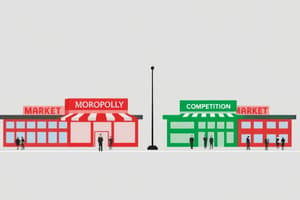Podcast
Questions and Answers
What happens to the quantity demanded for a firm's product at prices greater than the market equilibrium price?
What happens to the quantity demanded for a firm's product at prices greater than the market equilibrium price?
- It fluctuates based on consumer preferences.
- It decreases to zero. (correct)
- It increases significantly with price.
- It remains constant regardless of price.
What characterizes the demand curve along segment BC?
What characterizes the demand curve along segment BC?
- It is perfectly inelastic.
- It shows increasing elasticity.
- It is perfectly elastic. (correct)
- It has a finite elasticity.
How does monopolistic competition differ from perfect competition regarding advertising?
How does monopolistic competition differ from perfect competition regarding advertising?
- Advertising creates a perfectly elastic demand curve in monopolistic competition.
- Firms in monopolistic competition do not engage in advertising.
- Advertising decreases the overall market demand.
- Firms can differentiate their products through advertising. (correct)
What occurs when the price is set below the market equilibrium price?
What occurs when the price is set below the market equilibrium price?
What is the effect of advertising on the demand curve in monopolistic competition?
What is the effect of advertising on the demand curve in monopolistic competition?
Which of the following best describes a perfectly elastic demand curve?
Which of the following best describes a perfectly elastic demand curve?
In a market at equilibrium, what is true about the firm's pricing strategy?
In a market at equilibrium, what is true about the firm's pricing strategy?
What occurs if a firm in perfect competition attempts to increase its price?
What occurs if a firm in perfect competition attempts to increase its price?
At what price does the dominant firm initially set its demand curve according to point G?
At what price does the dominant firm initially set its demand curve according to point G?
How many total units does each competitive fringe firm produce when the dominant firm lowers the price to $1?
How many total units does each competitive fringe firm produce when the dominant firm lowers the price to $1?
What is the relationship between price and quantity demanded at point G on the dominant firm's demand curve?
What is the relationship between price and quantity demanded at point G on the dominant firm's demand curve?
What does the marginal cost of $1 correspond to for the competitive fringe firms?
What does the marginal cost of $1 correspond to for the competitive fringe firms?
If the dominant firm sets the price to $1.3, which concept does this illustrate regarding firm behavior?
If the dominant firm sets the price to $1.3, which concept does this illustrate regarding firm behavior?
What would be a result if the price for the dominant firm drops below $1?
What would be a result if the price for the dominant firm drops below $1?
What quantity represents total supply from the competitive fringe firms when they produce 3 units each?
What quantity represents total supply from the competitive fringe firms when they produce 3 units each?
How does the price change affect the elasticity of demand for the dominant firm?
How does the price change affect the elasticity of demand for the dominant firm?
How do new entrepreneurs using advertising mainly impact the demand curve of existing firms?
How do new entrepreneurs using advertising mainly impact the demand curve of existing firms?
What happens to the demand curve as more competitors enter the market?
What happens to the demand curve as more competitors enter the market?
Why do existing firms lower their product prices when new entrants come into the market?
Why do existing firms lower their product prices when new entrants come into the market?
How does the price elasticity of demand change for an existing firm as new competitors enter the market?
How does the price elasticity of demand change for an existing firm as new competitors enter the market?
What is the effect of a downward shift in the demand curve on the economic profits of existing firms?
What is the effect of a downward shift in the demand curve on the economic profits of existing firms?
What occurs when the demand curve of an existing firm slides below the long-run average cost curve?
What occurs when the demand curve of an existing firm slides below the long-run average cost curve?
In what way do close substitutes influence consumer behavior regarding an existing firm's product?
In what way do close substitutes influence consumer behavior regarding an existing firm's product?
Which of the following statements best describes the relationship between advertising and market entry of new firms?
Which of the following statements best describes the relationship between advertising and market entry of new firms?
Flashcards
Perfectly Elastic Demand Curve
Perfectly Elastic Demand Curve
A demand curve where any price increase, no matter how small, results in a complete loss of customers.
Market Equilibrium Price
Market Equilibrium Price
The price at which the quantity demanded equals the quantity supplied in a market.
Product Differentiation
Product Differentiation
Creating differences, real or perceived, in products to distinguish them from competitors' products.
Monopolistic Competition
Monopolistic Competition
Signup and view all the flashcards
Perceived Demand Curve
Perceived Demand Curve
Signup and view all the flashcards
Price Elasticity of Demand
Price Elasticity of Demand
Signup and view all the flashcards
Shifting Demand Curve (Upward)
Shifting Demand Curve (Upward)
Signup and view all the flashcards
Reducing Price Elasticity
Reducing Price Elasticity
Signup and view all the flashcards
Dominant firm demand curve point G
Dominant firm demand curve point G
Signup and view all the flashcards
Competitive fringe firms' output at $1
Competitive fringe firms' output at $1
Signup and view all the flashcards
Oligopoly with a price leader
Oligopoly with a price leader
Signup and view all the flashcards
Marginal Cost (MC)
Marginal Cost (MC)
Signup and view all the flashcards
Long-Run Average Cost (LRAC)
Long-Run Average Cost (LRAC)
Signup and view all the flashcards
Economic Profits' Effect on New Entrants
Economic Profits' Effect on New Entrants
Signup and view all the flashcards
Price Reduction by Existing Firms
Price Reduction by Existing Firms
Signup and view all the flashcards
Demand Curve Elasticity Increase
Demand Curve Elasticity Increase
Signup and view all the flashcards
Substitute Products and Willingness to Pay
Substitute Products and Willingness to Pay
Signup and view all the flashcards
Price Elasticity of Demand - Example
Price Elasticity of Demand - Example
Signup and view all the flashcards
Demand Curve Shift Downwards
Demand Curve Shift Downwards
Signup and view all the flashcards
Economic Profits and Market Entry
Economic Profits and Market Entry
Signup and view all the flashcards
Demand Curve Below Average Cost
Demand Curve Below Average Cost
Signup and view all the flashcards
Study Notes
Other Market Structures
- Firms, producers, suppliers, owners, and managers are used interchangeably.
- Perfect competition is an ideal market interaction type where free entry/exit controls self-interest, promoting public interest.
- Monopoly is the opposite extreme, with no free entry/exit, limited information, and inefficient resource allocation.
- Real world markets often fall between these extremes, exhibiting different levels of interaction and barriers to entry/exit.
- Market structure impacts the degree of self-interest exhibited by participants.
Market Structures Table
- Market Structure | Number of Firms | Type of Entry and Exit | Nature of Products | Elasticity of Demand
- --|---|---|---|---
- Perfect Competition | Large | Free | Homogenous | Perfectly Elastic
- Monopolistic Competition | Large | Free | Differentiated | Elastic
- Oligopoly | Small | Restricted | Differentiated | Elastic, Inelastic
- Cartel | Small or Large | No | Homogenous | Elastic, Inelastic
- Monopoly | One | No | Homogenous | Elastic, Inelastic
Monopolistic Competition
- Free entry and exit in the long run, but not in the short run.
- Many firms exist.
- Firms produce differentiated products.
- Firms have some control over their prices in the short run due to their differentiated products.
- Short run demand curve is relatively elastic, and becomes very elastic in the long run.
- Firms strive to create a loyal customer base through advertising to differentiate their products and shift their demand curves.
Oligopoly
- Few firms.
- Firms have restricted entry.
- Firms may produce homogenous or differentiated products.
- Firms often engage in strategic behavior (e.g., agreeing on prices, dividing markets).
- Example of firms in an oligopolistic market include manufacturers of cars.
Cartel
- A special type of oligopoly.
- Firms cooperate to act like a monopoly.
- Usually few firms in the cartels and it's easy for them to agree on prices to maximize profit.
- They often divide the market geographically, allowing each member to set prices and maximize profit in their assigned region
Monopolistic Competition - Short Run Equilibrium
- Firms aim to maximize economic profits.
- Firms choose quantity and price based on perceived demand and marginal cost.
- In short-run equilibrium, output is where marginal revenue (MR) equals marginal cost (MC).
- Price is set above average total cost.
Monopolistic Competition - Long Run Equilibrium
- Free entry and exit drive economic profit to zero in the long run.
- Firms operate where the price is equal to the average total cost.
- This results in normal profit.
Advertising and Product Differentiation
- Firms differentiate their products using trademarks, branding, advertising and technological advancements.
- This creates a core of loyal customers and enables firms to raise prices and increase demand.
Natural Oligopoly
- High economies of scale.
- Only a few, large firms can efficiently serve the market, making entry difficult.
- Example areas in this market are industries where large, fixed-cost capital is required to produce, transportation, electricity.
Studying That Suits You
Use AI to generate personalized quizzes and flashcards to suit your learning preferences.




